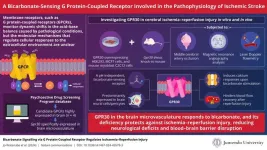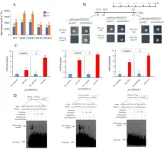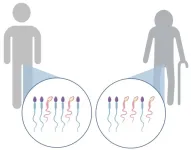(Press-News.org) Thousands of satellites take pictures, gather information and relay internet traffic from high above the Earth. Now, the challenge is making satellites that operate closer to home, in what is called a very low earth orbit (VLEO), where there is ample space for additional satellites, and the pictures taken would be clearer.
Working at an altitude with air would mean more force would be needed to propel the satellite forward, but many scientists believe there is also an advantage: the air could be used as the propellant. They say charged particles of air-breathing plasma – the fourth state of matter – could be used to propel the thrusters, potentially lightening the load and increasing the satellite’s lifespan. A satellite’s thrusters are essential to their ongoing operation, as they push the satellite around to keep it in the Earth’s orbit.
Researchers at the George Washington University (GWU) and the U.S. Department of Energy’s Princeton Plasma Physics Laboratory (PPPL) have teamed up to develop a proof of concept for such a propulsion system. Yevgeny Raitses, a managing principal research physicist at PPPL, is leading the Lab’s efforts on the project. PPPL’s expertise is needed to ensure the charged particles of plasma are neutralized as the plasma beam leaves the thruster. This is just one of many ways that PPPL’s plasma expertise supports critical U.S. infrastructure. The Defense Advanced Research Projects Agency (DARPA) has already provided $400,000 of an anticipated $1 million grant for the project.
“There is air available at VLEOs. So, instead of launching rockets with these propellants, such as xenon, krypton or argon, we can use what is naturally available: air,” Raitses said. “This should allow us to reduce the mass of satellites or allow them to dedicate the difference in mass to other aspects of the device. It might also extend the lifetime of the device.”
Air-breathing plasma propulsion
Current satellites have a lifespan limited by their power sources, propulsion systems and the propellant used to generate the plasma. Once the thrusters run out of the propellant, the satellite can no longer stay in orbit and needs to be replaced. The proposed thruster systems avoid this issue because the air that surrounds the satellite is used to generate the plasma. These air-breathing plasma thrusters would also eliminate the cost of the propellant.
PPPL has researched plasma thruster physics for decades, contributing multiple physics findings and engineering innovations. Several will be used to make the thruster prototypes. This includes the Lab’s ongoing work on plasma diagnostics, which will be used to study the thruster plasma. It is critical that positive and negative particles released from the thruster are leaving at the same rate so there is no net electric current in the plasma plume.
“It is important in order to avoid charging the satellites,” Raitses said, as that could cause charged particles released from the thruster to be attracted back to the satellite and cause a recoil. An electric current in the emissions could also cause electrical issues for the satellite.
“We will diagnose velocities of positive ions generated and accelerated from the thruster. From their trajectories and comparison with models by our partners at the George Washington University, we should be able to evaluate the neutralization process.”
Raitses will also use special probes developed at PPPL to measure key features of the plasma, such as its density and the temperature of its negatively charged particles.
The idea that the thruster itself can neutralize the particles is central to the DARPA project but raises additional questions that PPPL will help answer.
“The PPPL group led by Yevgeny has extensive experience in all these aspects,” says Michael Keidar, the A. James Clark Professor of Engineering at GWU. Keidar, a frequent PPPL collaborator via the Princeton Collaborative Low Temperature Plasma Research Facility (PCRF), is leading the GWU arm of the DARPA project. The GWU team includes doctoral student Anmol Taploo, who was a first author of the original work that led to this project. “The PCRF is well equipped with multiple relevant diagnostics tools, including laser-induced fluorescence that can help to evaluate dynamics of ion-charge neutralization,” Keidar said.
This research was funded by the George Washington University through SPP Agreement #7910. DARPA funding was provided to the George Washington University under agreement number HR0011-24-9-0330.
END
How decades of expertise with the fourth state of matter could bring satellites closer to Earth
PPPL’s plasma know-how can support critical U.S. infrastructure by enhancing satellite thruster technology
2024-02-27
ELSE PRESS RELEASES FROM THIS DATE:
Living near pubs, bars and fast-food restaurants could be bad for heart health
2024-02-27
Research Highlights
Closer proximity to and a higher number of ready-to-eat food outlets — particularly pubs, bars and fast-food restaurants — may be associated with a greater risk of developing heart failure, according to a study of half a million adults in the UK Biobank.
The association between food environments and increased heart failure risk was stronger among people who did not have a college degree and those living in urban areas without access to facilities for physical activity such as gyms or fitness centers.
Embargoed until 4 a.m. CT/5 a.m. ET Tuesday, Feb. 27, 2024
DALLAS, Feb. 27, 2024 — Living close to pubs, bars and fast-food restaurats may ...
Research adds to knowledge about heart disease and stroke in women of all ages
2024-02-27
Research Highlights:
Women’s heart disease and stroke risks and outcomes differ throughout life in comparison to men.
A special Journal of the American Heart Association “spotlight” issue features a collection of the latest research about sex differences in cardiovascular disease and their implications for gender-specific care.
Among the topics in this issue: the impact of sedentary behavior on heart disease risk in older women; sex differences in the relationship between schizophrenia and the development ...
Innovative therapies for ischemic stroke: Novel bicarbonate-sensing G protein-coupled receptor shows promise
2024-02-27
Cells actively rely on maintaining an appropriate acid-base balance to support optimal function. Under normal physiological settings, the pH inside cells remains within a controlled range. However, disruptions in this equilibrium have been linked to a wide range of health conditions, both minor and catastrophic. Changes in the extracellular environment are monitored by “membrane receptors,” of which the G protein-coupled receptors (GPCRs) are a large family of membrane proteins that mediate multiple cellular responses. However, the role of GPR30, also known as G protein-coupled estrogen ...
AI-driven lab speeds catalysis research
2024-02-27
Researchers have developed a “self-driving” lab that uses artificial intelligence (AI) and automated systems to provide in-depth analyses of catalytic reactions used in chemical research and manufacturing. The new tool, called Fast-Cat, can provide more information in five days than is possible in six months of conventional testing.
At issue are the yield and selectivity of chemical reactions in the presence of molecules called ligands.
Yield refers to how efficiently a chemical reaction produces a desired product from the chemicals you started with. Selectivity refers ...
Unveiling the sustainability landscape in cultural organizations: A global benchmark
2024-02-27
Are museums, theaters, and opera houses truly walking the talk when it comes to social and environmental sustainability? The University of Lausanne (UNIL) delved into this pressing question, conducting an international survey with over 200 major cultural organizations. The verdict? While there's significant room for improvement across the spectrum, Anglophone countries lead the charge.
Cultural organizations, with their wide-reaching influence and power to shape narratives and imaginations, are poised to ...
The mechanism of SlWRKY80 participating in salt alkali stress through its involvement in JA metabolic pathway
2024-02-27
Tomato (Solanum lycopersicum L.) is the most widely cultivated and consumed horticultural crop. At present, saline–alkali is an important abiotic stress source that affects tomato production. Exogenous methyl jasmonate (MeJA) can enhance the resistance of tomatoes to various stress, but its exact mechanism is still unclear.
In January 2024, Horticulture Research published a research entitled by “SlWRKY80-mediated jasmonic acid pathway positively regulates tomato resistance to saline-alkali stress by enhancing spermidine content and stabilizing ...
Abdominal fat can impact brain health and cognition in high Alzheimer’s risk individuals
2024-02-27
The impact of abdominal fat on brain health and cognition is generally more pronounced in middle-aged men at high risk of Alzheimer’s disease as opposed to women, according to researchers at Rutgers Health.
In middle-aged individuals with a family history of Alzheimer’s disease, the amount of fat in their abdominal organs (pancreas, liver, and belly fat) is related to their brain volumes and cognitive function, according to the study published in the journal Obesity. The study was written by Sapir Golan Shekhtman, a Ph.D. student at the Joseph Sagol Neuroscience Center at the Sheba Medical Center in Israel and led by ...
New data analysis supports hedonic overdrive model in high-fat diet-induced mice
2024-02-27
ROCKVILLE, Md.— High-fat diets cause obesity in male mice. The underlying mechanism, however, remains controversial. After assessing three contrasting ideas, researchers have determined that the hedonic overdrive model provides the best fit, according to a new study published in the journal Obesity, The Obesity Society’s (TOS) flagship journal.
“Our work provides some direction as to why high-fat/high-carb macronutrient combinations stimulate overconsumption. The study is in mice so we ...
Pythagoras was wrong: there are no universal musical harmonies, new study finds
2024-02-27
The tone and tuning of musical instruments has the power to manipulate our appreciation of harmony, new research shows. The findings challenge centuries of Western music theory and encourage greater experimentation with instruments from different cultures.
According to the Ancient Greek philosopher Pythagoras, ‘consonance’ – a pleasant-sounding combination of notes – is produced by special relationships between simple numbers such as 3 and 4. More recently, scholars have tried to find psychological explanations, but these ‘integer ratios’ are still credited with making a chord sound beautiful, and deviation from them ...
Researchers uncover new clues about links between parent age and congenital disorders
2024-02-27
A new paper in Genome Biology and Evolution, published by Oxford University Press, finds that the link between paternal age and rare congenital disorders is more complex than scientists had previously thought. While researchers have long realized that older fathers are more likely to have children with bone and heart malformations, such as Achondroplasia, Apert, or Noonan syndrome or neurodevelopmental disorders, schizophrenia, and autism, new examination indicates that while the link between some pathogenic mutations increases with paternal age, others do not and may even occur in the father’s testis before sexual maturity.
Delayed fatherhood results in a higher ...
LAST 30 PRESS RELEASES:
Tracing the quick synthesis of an industrially important catalyst
New software sheds light on cancer’s hidden genetic networks
UT Health San Antonio awarded $3 million in CPRIT grants to bolster cancer research and prevention efforts in South Texas
Third symposium spotlights global challenge of new contaminants in China’s fight against pollution
From straw to soil harmony: International team reveals how biochar supercharges carbon-smart farming
Myeloma: How AI is redrawing the map of cancer care
Manhattan E. Charurat, Ph.D., MHS invested as the Homer and Martha Gudelsky Distinguished Professor in Medicine at the University of Maryland School of Medicine
Insilico Medicine’s Pharma.AI Q4 Winter Launch Recap: Revolutionizing drug discovery with cutting-edge AI innovations, accelerating the path to pharmaceutical superintelligence
Nanoplastics have diet-dependent impacts on digestive system health
Brain neuron death occurs throughout life and increases with age, a natural human protein drug may halt neuron death in Alzheimer’s disease
SPIE and CLP announce the recipients of the 2025 Advanced Photonics Young Innovator Award
Lessons from the Caldor Fire’s Christmas Valley ‘Miracle’
Ant societies rose by trading individual protection for collective power
Research reveals how ancient viral DNA shapes early embryonic development
A molecular gatekeeper that controls protein synthesis
New ‘cloaking device’ concept to shield sensitive tech from magnetic fields
Researchers show impact of mountain building and climate change on alpine biodiversity
Study models the transition from Neanderthals to modern humans in Europe
University of Phoenix College of Doctoral Studies releases white paper on AI-driven skilling to reduce burnout and restore worker autonomy
AIs fail at the game of visual “telephone”
The levers for a sustainable food system
Potential changes in US homelessness by ending federal support for housing first programs
Vulnerability of large language models to prompt injection when providing medical advice
Researchers develop new system for high-energy-density, long-life, multi-electron transfer bromine-based flow batteries
Ending federal support for housing first programs could increase U.S. homelessness by 5% in one year, new JAMA study finds
New research uncovers molecular ‘safety switch’ shielding cancers from immune attack
Bacteria resisting viral infection can still sink carbon to ocean floor
Younger biological age may increase depression risk in older women during COVID-19
Bharat Innovates 2026 National Basecamp Showcases India’s Most Promising Deep-Tech Ventures
Here’s what determines whether your income level rises or falls
[Press-News.org] How decades of expertise with the fourth state of matter could bring satellites closer to EarthPPPL’s plasma know-how can support critical U.S. infrastructure by enhancing satellite thruster technology



